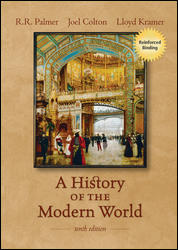 
History of the Modern World, 10th Edition (Palmer)Chapter 5:
The Transformation of Eastern Europe, 1648-1740Learning ObjectivesChapter 5 teaches students about:
How three old-fashioned political organizations, the Holy Roman Empire, the Republic of Poland, and the Ottoman empire, were pushed aside by newer, stronger powers. |
 |  |  |
The expansion and westernization of Russia. |
 |  |  |
The declining freedoms of peasants east of the Elbe in the sixteenth, seventeenth, and eighteenth centuries. |
 |  |  |
The power of landlords in eastern Europe, and their control of the agricultural estate, the main social unit of the region. |
 |  |  |
The common factors of weakness among the aging empires, including a lack of central authority, inefficient administration and government, and the diversity of the peoples within those empires. |
 |  |  |
The renewed power of the Habsburgs, who recovered from the humiliation of the settlement dictated by the Peace of Westphalia and created an international empire. |
 |  |  |
The Swedish transition from a great power to a small one. |
 |  |  |
The ascendancy of the Hohenzollerns, and their triumph over the Holy Roman Emperor in acquiring the title of king of Prussia. |
 |  |  |
Prussian militarism and its impact on Prussian society. |
 |  |  |
How the three new powers in eastern Europe borrowed ideas and administrative systems from western Europe while maintaining their distinctive political, social, and cultural characteristics. |
 |  |  |
The process of westernizing Russia undertaken by Peter the Great, which provoked a social revolution. |
 |  |
|





